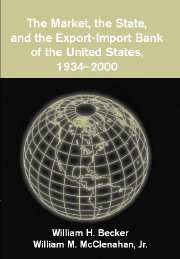Book contents
- Frontmatter
- Contents
- Preface and Acknowledgments
- Introduction
- 1 Setting a Flexible Course: The Export-Import Bank, 1934–1939
- 2 World War and Its Aftermath
- 3 Cold War and the Needs of a New Era, 1948–1961
- 4 Becoming “Two Institutions”
- 5 New Mandates and New Limits
- 6 Turmoil and Turning Points
- 7 A New Era and Its Challenges, the 1990s
- Epilogue
- Appendix A Board of Directors
- Appendix B Summary of Authorizations
- Appendix C Number of Authorizations
- Appendix D Charges Against Statutory Limitations on Total Activity
- Index
7 - A New Era and Its Challenges, the 1990s
Published online by Cambridge University Press: 13 July 2009
- Frontmatter
- Contents
- Preface and Acknowledgments
- Introduction
- 1 Setting a Flexible Course: The Export-Import Bank, 1934–1939
- 2 World War and Its Aftermath
- 3 Cold War and the Needs of a New Era, 1948–1961
- 4 Becoming “Two Institutions”
- 5 New Mandates and New Limits
- 6 Turmoil and Turning Points
- 7 A New Era and Its Challenges, the 1990s
- Epilogue
- Appendix A Board of Directors
- Appendix B Summary of Authorizations
- Appendix C Number of Authorizations
- Appendix D Charges Against Statutory Limitations on Total Activity
- Index
Summary
INTRODUCTION
Following the unprecedented international and domestic economic problems the United States faced in the 1980s and early 1990s, circumstances during the rest of the last decade of the twentieth century improved markedly. These changes influenced the Bank and its work. By 1992, recession gave way to the beginnings of a lengthy domestic economic boom, highlighted by an expanding export sector. Internationally, conditions also brightened. The Latin American debt crisis had abated following the substantial rescheduling of debt championed by U.S. Secretary of the Treasury Nicholas F. Brady in 1989.
In 1993, the Clinton administration embarked on an effort to stem the growth of the country's very large budget deficits. Spurred on by a Republican victory in the 1994 congressional elections, the White House and Congress both sought deficit reduction. By 1999, the federal government accumulated its first surplus since 1969. These conditions accelerated foreign capital flows to the United States, which fueled not only the stock market but also private business investment. The latter helped drive new network computer and telecommunications technologies that together fostered a revolution in “information technology” (IT). The latter made possible the commercialization of the Internet, perhaps the most important technological breakthrough of the 1990s. The United States became the leader in the new technologies, which were attractive candidates for export, despite the strong dollar. Additionally, in its first years in office, the Clinton administration embarked on an expansive export drive.
- Type
- Chapter
- Information
- Publisher: Cambridge University PressPrint publication year: 2003



